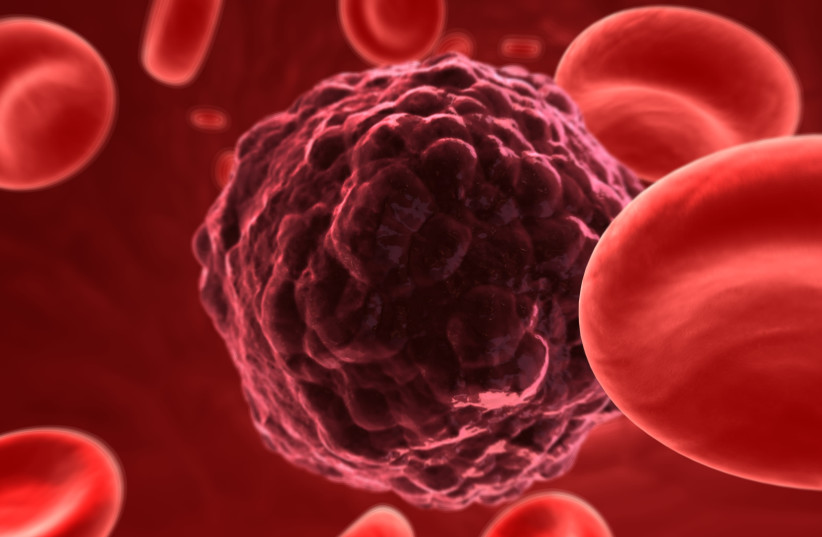Israeli men are much more likely to get lung cancer than Israeli women, according to the latest report of the National Center for Disease Control in the Health Ministry that provided lung cancer data for the years 1996 to 2019. In 2019, there were 2,739 new cases of lung cancer diagnosed in Israel, 61.3% of them men and 38.7% women.
A total of 1,904 patients with lung cancer – most of the cases caused by active tobacco smoking or in non-smokers passively exposed to others’ smoking – died in 2019. Lung cancer is responsible for 9.8% of all new cancer cases in Israel and 16.2% of all cancer deaths.
There was a decrease in deaths from lung cancer among Jewish men throughout the examined period, and a decrease among Jewish women starting in 2011. Mortality trends among Arab women and men decreased significantly beginning in 2015, but they are now stable among Arab women throughout the years examined.
There had been a decrease in the incidence of lung cancer among Jewish men and an increase among Jewish women until 2014. The incidence of the disease among Arab women and men has remained stable.
The authors of the report said it was possible that the stabilization of cancer-incidence trends was related to the decrease in the number of tobacco smokers here in recent decades. In all age groups, the highest rate of lung cancer was observed in Arab men, and the lowest in Arab women.

The authors of the report said it was possible that the stabilization of cancer-incidence trends was related to the decrease in the number of tobacco smokers here in recent decades. In all age groups, the highest rate of lung cancer diagnosis was observed in Arab men and the lowest, in Arab women.
Most Israelis diagnosed with lung cancer are aged 55 and older.
Majority of cases were diagnosed in those who smoke
The absolute majority of lung cancer cases (80%-90%) are diagnosed in patients who smoke or have smoked in the past. In 2019, only 8.7% of all patients were younger than 55. This year, the average age at diagnosis among Jewish men was 70.4, similar to the average age among Jewish women (70.5). Among Arab men, the average age at diagnosis was 65.8, and 64.6 among Arab women. As of 2020, the percentage of smokers in Israel ages 15 and over was 16.4% – slightly higher than the rate of the OECD countries’ 16.1%.
There are two main types of lung cancer – small-cell lung cancer (SCLC) and non-small cell lung cancer (NSCLC). The two behave and respond to treatment differently. There are also other, rarer types.
SURVIVAL RATES from lung cancer have increased over the years in most gender and population groups. For Jewish men, the survival rate of those diagnosed from 1996 to 2001 increased significantly from 15.8% to 23.2%, compared to those diagnosed from 2008 to 2014. Among Jewish women, there was a significant increase in survival from lung cancer, from 23.9% for those diagnosed in 1996 to 2001, to 36.2% for those diagnosed from 2008 to 2014. In relation to Arab women, there was a significant increase in survival rates, when they rose from 18.3% from 1996-2001 to 33.4% from 2008 to 2014.
In an international comparison, out of 186 regional and national cancer registries reported to the World Health Organization (WHO), Israel ranks 42nd in terms of lung cancer incidence and 66th in deaths caused by tobacco.
Early diagnosis of lung cancer is based on low-dose computerized tomography (CT) examinations once a year. This test enables the detection of the disease at an early stage, which allows for treatment with the aim of curing most of the cases detected. For this reason, an early screening for lung cancer is recommended among the risk population: ages 55 to 74 and active smokers or those who stopped up to 15 years ago.
The Health Ministry is now running the pilot program for the early detection of lung cancer. The program received a mandate to build an implementation model in the health system through a process for locating, summoning and testing suitable candidates to perform a low-dose CT scan with a target population of 10,000 smokers or ex-smokers ages 50 to 79 (depending on the level of intensity of their smoking). When the pilot program’s findings are available, the ministry will decide what steps to take regarding a wider inclusion of patients.
Prof. Lital Keinan-Boker, director of the National Center for Disease Control, said, “Arab men have the highest risk of lung cancer, which reflects, among other things, their very high rates of smoking. In the 24 years between 1996 and 2019, the risk of the disease in Arab men remained stable. This is compared to a clear decrease in recent years in Jewish men and others. This is a serious and even fatal disease, and the mortality trends largely reflect the risk of contracting it.”
Active and passive (second-hand) tobacco smoking is a major risk factor for the disease. It can be assumed that the observed trends reflect, among other things, activity to reduce and prevent smoking, which includes legislation led by the ministry, said Keinan-Boker.
“There is no doubt that we must intensify our efforts to stop smoking and prevent the initiation of smoking among Arab men. Tracking the trends, both of smoking rates and those of morbidity and mortality from lung cancer, makes it possible to identify at-risk groups and monitor the effect of various intervention programs.”
